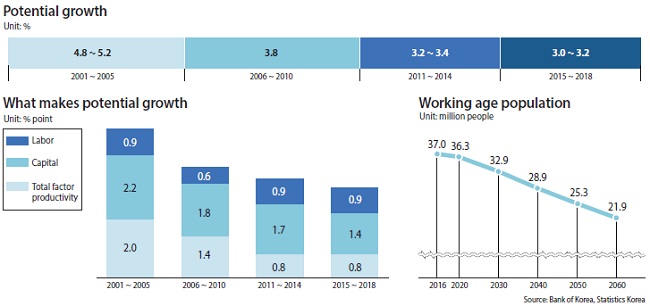BOK warns of possible era of slowing growth

According to a study by the Bank of Korea released on Wednesday, Korea’s so-called potential economic growth rate for the period between 2015 and 2018 is between 3 percent and 3.2 percent. This is a drop of 2 percentage points compared to 15 years ago, when the maximum potential growth was 5.2 percent.
Potential gross domestic product is defined by the OECD as the level of output that an economy can produce at a constant inflation rate. Organizations like the Bank of Korea use that to project potential economic growth rates for periods. Decreases may suggest an economy is losing sustainability in the long run. Growth in total factor productivity, labor and capital determine the potential economic growth.
The central bank released the report to support its earlier cut in the growth forecast last year. It slashed its 2016 growth outlook for the local economy to 3.2 percent from 3.3 percent in a quarterly report released in October. In December, the central bank implied it can further cut the growth forecast for this year, citing downward risks in the global economy and slowing production.
The Bank of Korea report said the country’s potential economic growth rate started to dwindle from around 5 percent in the period between 2000 and 2005 to the mid-3 percent range in the 2011-14 period. A turning point was the 2008 global financial meltdown.
Kang Hwan-koo, the author of the report, said the country’s potential economic growth rate has slipped to the low-3 percent range for the 2015-18 period.
“The country’s growth potential is projected to keep dwindling even after the impact of the 2008 global financial crisis fades away,” Kang said in the report.
Slow technological advances reduced the country’s overall industrial productivity, the report said, which can be partly attributed to slower growth in the country’s total population amid the accelerated aging of the Korean population.
Korea’s total factor productivity, referring to productivity determined by all factors excluding labor and capital, dropped from 2 percent in 2000 to 0.8 as of last year, the report showed.
“The fall in the productivity index reflects slow advancements in technology development, which has led to slow improvements in the competitiveness of the services sector, accumulation of zombie companies and growing imbalances,” the researcher said. “As for productivity, declines in the country’s birthrate and aging of the population will lead to a slowing supply of labor.”
According to data by Statistics Korea, the country’s working age population is estimated to start falling from 2017, from about 37 million people to 22 million by 2060.
The global slowdown has affected capital investments in the country, also causing the country’s growth potential to slide significantly.
Capital growth accounted for 2.2 percent of the country’s potential growth rate in 2000, but slid to 1.4 percent, the report showed.
Korea needs a wide range of deregulations and more incentives for R&D investments, the report suggested.
BY SONG SU-HYUN [song.suhyun@joongang.co.kr]










with the Korea JoongAng Daily
To write comments, please log in to one of the accounts.
Standards Board Policy (0/250자)